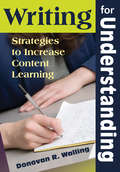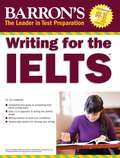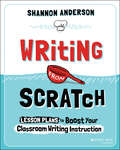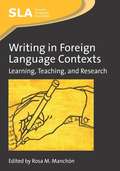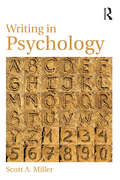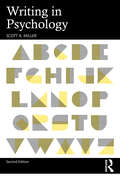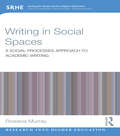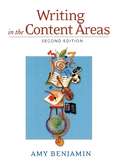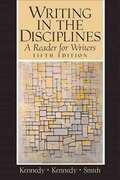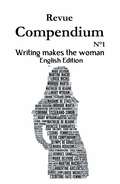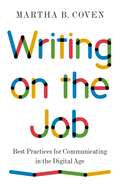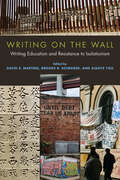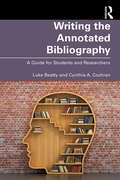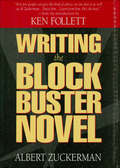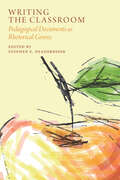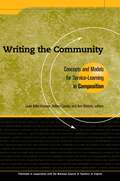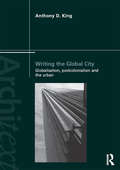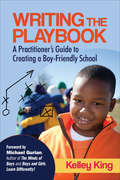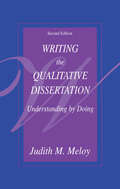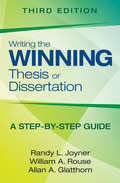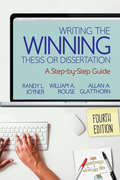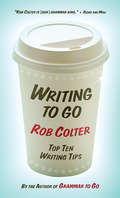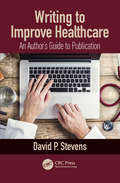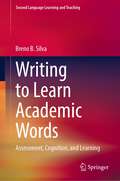- Table View
- List View
Writing for Understanding: Strategies to Increase Content Learning
by Donovan R. WallingWritten specifically for non–language arts teachers, this resource focuses on using writing as an instructional tool to deepen and expand student understanding in the content areas.
Writing for the IELTS
by Lin LougheedDiscover everything you’ll need to know in order to write well for the IELTS test, whether you are planning to take the Academic or the General Training version. This book will help IELTS test takers learn several essential skills, including:Task Achievement: follow a three-step model to plan, write, and revise your essaysCoherence and Cohesion: practice organizing your writing and connecting ideasLexical Resource: build your vocabulary and use it correctlyGrammatical Range and Accuracy: review rules and practice applying them to your writingEach section leads you step-by-step through the process of writing an essay in response to a particular task. Learn how to apply what you’ve learned, familiarize yourself with the types of questions you’ll have to respond to on the test, complete your responses within the time limits, and more. An Appendix also includes a More Writing Practice section with a selection of essays written in response to IELTS writing tasks.
Writing from Scratch: Lesson Plans to Boost Your Classroom Writing Instruction
by Shannon AndersonEffective, engaging strategies that will boost your confidence in teaching writing Writing from Scratch is a positive, encouraging book full of practical techniques for elementary teachers and students to get the most out of their writing time. Award-winning author Shannon Anderson presents specific, skill-based lessons through a running theme of baking and cooking. Each lesson, or “recipe,” will help you serve up effective instruction on writing topics like idea generation, figurative language, plotting, and structure. This book is designed not just to develop student writing, but to develop students as writers. The experiences and guidance in Writing From Scratch will inspire you to plan a year-long curriculum—or jump in mid-year—for writing instruction that will make a difference for students today, and into the future. Get practical ideas for incorporating writing lessons into your elementary classroom Build writing exercises into content lessons, for added writing instruction Inspire students to get excited about writing and explore their identities as writers Gain the confidence you need to plan a full writing curriculum Teachers in K-5 settings, as well as principals and education leaders, will benefit from this hands-on writing instruction guide. Perfect for solo use or as a guide for professional development, Writing From Scratch will have you cooking up fantastic writing lessons in no time!
Writing in Foreign Language Contexts
by Rosa ManchonThis book represents the most comprehensive account to date of foreign language (FL) writing. Its basic aim is to reflect critically on where the field is now and where it needs need to go next in the exploration of FL writing at the levels of theory, research, and pedagogy, hence the two parts of the book: 'Looking back' and 'Looking ahead'. The chapters in Part I offer accounts of both the inquiry process followed and the main insights gained in various long-term research programs. The chapters in Part 2 contribute a retrospective analysis of the available empirical research and of professional experiences in an attempt to move forward. The book invites the reader to step back and rethink seemingly well established knowledge about L2 writing in light of what is known about writing in FL contexts.
Writing in Psychology
by Scott A. MillerThis book helps readers become better writers of psychology and better writers in general. After reading thousands of course papers, theses, and dissertations, Dr. Miller knows and addresses the issues that students find most challenging when writing about psychology. Written with the utmost flexibility in mind, the chapters can be read in any order. More comprehensive than similar texts, this book provides detailed coverage of how to write empirical reports, research proposals, and literature reviews, and how to read meta-analyses. Readers will also find invaluable strategies for improving one’s writing including how to adopt an engaging yet accurate style, thorough coverage of grammatical and word use rules that govern writing in general, and the APA (American Psychological Association) rules that govern the expression of that content. Readers will appreciate these helpful learning tools: Describes the most common APA style rules encountered and/or highlights references to the Manual when more detailed knowledge is required. Numerous examples from journal articles that help readers gain a clearer understanding of content they will encounter in writing psychological reports. Chapter exercises that provide an opportunity to apply the points conveyed in each chapter. Examples of the most common mistakes made by students and how to avoid them and best practices for improving one’s writing. Tables that help readers gain a clearer understanding of the new standards in the APA Publications Manual, 6th ed (Appendix A). Errors in APA Style exemplified via an improperly formatted paper and another version noting corrections pertaining to APA style and grammar, to highlight the most common pitfalls encountered by students (Appendix B). Ideal for courses on writing in psychology or as a supplement for graduate or advanced undergraduate courses in research design or research methods, this book also serves as a resource for anyone looking for guidance on how to write about psychological content.
Writing in Psychology
by Scott A. MillerThe second edition of Writing in Psychology by Scott A. Miller is a comprehensive guide to addressing the most challenging issues that students face while writing about psychology, including what to say and how to say it. It offers practical tools to overcome the challenges and create an engaging work. The book is a valuable resource for helping readers become better writers of psychology with the aid of various helpful learning tools, which provide detailed coverage of how to write empirical reviews, research proposals, literature reviews, term papers, and posters. It examines examples from journal articles that give readers a grasp of the content they will encounter in writing psychological reports. Furthermore, it includes exercises that provide an opportunity to apply the points conveyed in each chapter, examples of ways to avoid the most common mistakes made by students, and a guide to the best practices for improving one’s writing. Readers will also develop a thorough understanding of how to write in an engaging yet accurate style, using grammatical and word use rules that govern writing in general, and the rules of seventh edition APA (American Psychological Association) Publication Manual that determine the expression of that content. Throughout, the book emphasizes inclusion, diversity, and fair treatment of those with whom psychologists deal, in research and writing. The book will benefit anyone looking for guidance on how to write about psychological content. It is ideal for research scholars and psychology students as a primary text for writing in psychology courses and a supplement for graduate or advanced undergraduate courses in research design or research methods.
Writing in Social Spaces: A social processes approach to academic writing (Research into Higher Education)
by Rowena MurrayWriting in Social Spaces addresses the problem of making time and space for writing in academic life and work of the professionals and practitioners who do academic writing'. Even those who want to write, who know how to write well and who have quality publications, report that they cannot find enough time for writing. Many supervisors are unsure about how to help postgraduates improve their writing for thesis and publication. Whilst the problem does presents through concerns with ‘time’, it is also partly about writing practices, academic identities and lack of motivation. This book provides a research-based, theorised approach to the skill of writing whilst retaining a link to writing practices and giving immediate yet sustainable solutions to the writing problem. It supplies new theory and practice on: socializing writing-in-progress and writing with others exploring the alternation of conscious and unconscious, internal and external processes in academic writing whilst in a social grouping Applying social processes in the writing process Using case studies and vignettes of writing in social spaces to illustrate the theory in practice, This book is a valuable resource for academics, scholars, professionals and practitioners, as well as researchers at all stages of their career, and in all disciplines.
Writing in the Content Areas
by Amy BenjaminDo you spend entirely too much time correcting your students' papers? Do your students' essays and term papers take side trips to nowhere? Is their writing riddled with mechanical errors? Do their lab reports and essays lack specificity and clarity? Writing in the Content Areas, Second Edition is for middle and high school content area teachers who assign essays, term papers, lab reports, and other writing tasks to students. This book provides strategies and tips to help teachers of social studies, science, art, etc. improve the quality of students' writing and apply national and state curriculum standards in your classroom. The strategies in this book can be integrated easily into every teacher's daily plans. They will help your students improve their abilities to - reflect before writing - organize and classify - provide detail without padding - use technical terminology correctly - avoid unnecessary words - spell correctly- take useful notes while they read and during your lectures.This book will help teachers - get what they want from a writing task - frame their assignments more precisely - correct student papers more quickly and efficientlyThe new second edition offers activities and strategies which involve technology (word processing, presentation programming, the Internet, and e-communications), differentiated instruction, and brain-based learning.
Writing in the Disciplines: A Reader for Writers
by William J. Kennedy Mary Lynch Kennedy Hadley M. SmithThis combination rhetoric/anthology shows readers how to read academic volumes effectively and how to use them as sources for papers in a variety of disciplines. Throughout, readers learn how to work individually and collaboratively as they move through the entire process of writing from sources?from reading the original source to planning, drafting and revising essays. The rhetoric section teaches readers the fundamental strategies for all phases of academic writing?critical reading, paraphrasing, summarizing, quoting, organizing, drafting, revising, editing, synthesizing, analyzing, researching, and developing arguments. The anthology section offers engaging reading selections that introduce readers to the issues and the methods of study in the sciences, social sciences, and humanities, and that serve as idea banks for their writing assignments. For individuals interested in a comprehensive treatment of academic writing.
Writing makes the woman: Excerpts from selected texts and contributions (1 of 1 #1)
by Stanislas KazalCompendium means an abstract or summary, in the form of a compilation, of a corpus of knowledge in a given field. If some women have been great writers and have been pushed to genius by the eloquence of the heart, the delicacy of the mind, the wisdom of judgment, the art of grouping the entire world around them, the literary history has often been reserved to only a small portion. We, Corinne Tisserand -Simon and I had after this observation, the desire to give read extracts that testify to the fact that literature is not built solely from the male point of view. It is time to say that women's writing is not an epiphenomenon in literary history to pave the way for a reading that would take into account the obstacles, the compromises, the weight of forms and norms with which women fought, flayed, censored to pass as they could then, under a speech sometimes too agreed, too suitable, under masks, denial or forbidden, a woman's writing.
Writing on the Job: Best Practices for Communicating in the Digital Age
by Martha B. CovenA practical and compact guide to writing for professionalsWriting is an essential skill in today’s workplace. From messaging platforms and social media to traditional forms of communication like memos and reports, we rely on words more than ever. Given how much reading we do on mobile devices, being able to write succinctly is critical to success. Writing on the Job is an incisive guide to clear and effective writing for professionals.Martha Coven begins with the basics, explaining how to develop a professional style, get started on a piece of writing, create a first draft, and edit it into a strong final product. She then offers practical advice on more than a dozen forms of writing, from emails and slide decks to proposals and cover letters. Along the way, Coven provides a wealth of concrete examples and simple templates that make the concepts easy to understand and apply.Based on Coven’s popular writing classes and workshops at Princeton University as well as her decades of experience in the public and private sectors, Writing on the Job addresses the real challenges professionals face in today’s digital age, and shares essential practices that can improve the performance of any organization.
Writing on the Wall: Writing Education and Resistance to Isolationism
by David S. Martins Xiaoye You Brooke R. SchreiberThe first concerted effort of writing studies scholars to interrogate isolationism in the United States, Writing on the Wall reveals how writing teachers—often working directly with students who are immigrants, undocumented, first-generation, international, and students of color—embody ideas that counter isolationism. The collection extends existing scholarship and research about the ways racist and colonial rhetorics impact writing education; the impact of translingual, transnational, and cosmopolitan ideologies on student learning and student writing; and the role international educational partnerships play in pushing back against isolationist ideologies. Established and early-career scholars who work in a broad range of institutional contexts highlight the historical connections among monolingualism, racism, and white nationalism and introduce community- and classroom-based practices that writing teachers use to resist isolationist beliefs and tendencies. “Writing on the wall” serves as a metaphor for the creative, direct action writing education can provide and invokes border spaces as sites of identity expression, belonging, and resistance. The book connects transnational writing education with the fight for racial justice in the US and around the world and will be of significance to secondary and postsecondary writing teachers and graduate students in English, linguistics, composition, and literacy studies. Contributors: Olga Aksakalova, Sara P. Alvarez, Brody Bluemel, Tuli Chatterji, Keith Gilyard, Joleen Hanson, Florianne Jimenez Perzan, Rebecca Lorimer Leonard, Layli Maria Miron, Tony D. Scott, Kate Vieira, Amy J. Wan
Writing the Annotated Bibliography: A Guide for Students & Researchers
by Luke Beatty Cynthia A CochranThis comprehensive and practical guide covers the elements, style, and use of annotated bibliographies in the research and writing process for any discipline; key disciplinary conventions; and tips for working with digital sources. Written jointly by a library director and a writing center director, this book is packed with examples of individual bibliography entries and full bibliography formats for a wide range of academic needs. Online resources include sample bibliographies, relevant web links, printable versions of checklists and figures, and further resources for instructors and researchers. Writing the Annotated Bibliography is an essential resource for first-year and advanced composition classes, courses in writing across the disciplines, graduate programs, library science instruction programs, and academic libraries at the secondary level and beyond. It is suitable for both undergraduate and graduate students and for researchers at all levels.
Writing the Blockbuster Novel
by Al ZuckermanEvery novelist dreams of it--writing the book that rockets to the top of the best-seller lists. Now, they can see how it's done, up close, in a book by an agent who has sold manuscripts that turned into hits.<P><P> Here Albert Zuckerman covers the essential elements of the blockbuster novel and shows writers how to put them to work in their books. Zuckerman covers the subject thoroughly, from creating outlines and building larger than life characters to injecting suspense and more. His instruction is decisive, direct and clear and is supported with examples from Gone With the Wind, The Godfather and other blockbusters.
Writing the Classroom: Pedagogical Documents as Rhetorical Genres
by Megan Knight Lori Ostergaard Jim Nugent Lora Arduser Christina Saidy Kate Navickas Logan Bearden Megan Schoen Michael Albright Virginia M. Schwarz Jessica Rivera-Mueller Dustin Morris Lindsay Clark Amy Ferdinandt Stolley Christopher Toth Dana Comi Mark A. Hannah Matt Dowell Cindy Mooty Lesley Erin Bartlett Laura R. Micciche Cynthia Pengilly Kate Nesbit Zack K. De PieroWriting the Classroom explores how faculty compose and use pedagogical documents to establish classroom expectations and teaching practices, as well as to articulate the professional identities they perform both inside and outside the classroom. The contributors to this unique collection employ a wide range of methodological frameworks to demonstrate how pedagogical genres—even ones as seemingly straightforward as the class syllabus—have lives extending well beyond the classroom as they become part of how college teachers represent their own academic identities, advocate for pedagogical values, and negotiate the many external forces that influence the act of teaching. Writing the Classroom shines a light on genres that are often treated as two-dimensional, with purely functional purposes, arguing instead that genres like assignment prompts, course proposals, teaching statements, and policy documents play a fundamental role in constructing the classroom and the broader pedagogical enterprise within academia. Writing the Classroom calls on experienced teachers and faculty administrators to critically consider their own engagement with pedagogical genres and offers graduate students and newer faculty insight into the genres that they may only now be learning to inhabit as they seek to establish their personal teacherly identities. It showcases the rhetorical complexity of the genres written in the service of pedagogy not only for students but also for the many other audiences within academia that have a role in shaping the experience of teaching. Contributors: Michael Albright, Lora Arduser, Lesley Erin Bartlett, Logan Bearden, Lindsay Clark, Dana Comi, Zack K. De Piero, Matt Dowell, Amy Ferdinandt Stolley, Mark A. Hannah, Megan Knight, Laura R. Micciche, Cindy Mooty, Dustin Morris, Kate Navickas, Kate Nesbit, Jim Nugent, Lori A. Ostergaard, Cynthia Pengilly, Jessica Rivera-Mueller, Christina Saidy, Megan Schoen, Virginia Schwarz, Christopher Toth
Writing the Community: Concepts and Models for Service-Learning in Composition
by Robert Crooks Ann Watters Linda Adler-KassnerThe first volume in AAHE and Campus Compact’s series on service-learning in the disciplines, the book discusses the microrevolution in college-level Composition through service-learning. The essays in this volume show why service-learning and communication are a natural pairing and give a background on the relationship between service-learning and communication with maps to suggest where it should go in the future.
Writing the Global City: Globalisation, Postcolonialism and the Urban (Architext)
by Anthony D KingOver the last three decades, our understanding of the city worldwide has been revolutionized by three innovative theoretical concepts – globalisation, postcolonialism and a radically contested notion of modernity. The idea and even the reality of the city has been extended out of the state and nation and re-positioned in the larger global world. In this book Anthony King brings together key essays written over this period, much of it dominated by debates about the world or global city. Challenging assumptions and silences behind these debates, King provides largely ignored historical and cultural dimensions to the understanding of world city formation as well as decline. Interdisciplinary and comparative, the essays address new ways of framing contemporary themes: the imperial and colonial origin of contemporary world and global cities, actually existing postcolonialisms, claims about urban and cultural homogenisation and the role of architecture and built environment in that process. Also addressed are arguments about indigenous and exogenous perspectives, Eurocentricism, ways of framing vernacular architecture, and the global historical sociology of building types. Wide-ranging and accessible, Writing the Global City provides essential historical contexts and theoretical frameworks for understanding contemporary urban and architectural debates. Extensive bibliographies will make it essential for teaching, reference and research.
Writing the Playbook: A Practitioner’s Guide to Creating a Boy-Friendly School
by Ms Kelley E. KingYour game plan for getting boys on the path to higher achievement As a school leader, Kelley King has walked the talk: she successfully led her own staff to close the achievement gap between boys and girls in reading and writing in just one year. In this book, readers get King’s step-by-step, research-based leadership plan for jump-starting boys’ achievement. King shares: Critical insight into the brain-based differences between boys and girls First-hand leadership and classroom experiences to provide educators with a blueprint for creating schools where boys (and girls!) thrive Ready-to-use activities and resources for leading a successful gap-closing initiative
Writing the Qualitative Dissertation: Understanding by Doing
by Judith M. MeloyThe purpose of this book is to share, in rich detail, an understanding of how it feels and what it means to do qualitative research, and to provide support for doctoral students who choose this form of inquiry for their dissertation research.
Writing the Winning Thesis or Dissertation: A Step-by-Step Guide
by Randy L. Joyner Dr William A. Rouse Allan A. GlatthornThe classic guide for master's and doctoral students—newly revised and updated! Used in its first two editions by tens of thousands of students, this practical book demystifies the process of writing your master's thesis or doctoral dissertation, taking you through the process one step at a time. Newly revised and updated, this book provides specific models and examples that will guide you through: Laying the groundwork for the thesis or dissertation Organizing and scheduling your work Collaborating with peers Using technology Solving problems throughout the dissertation process
Writing the Winning Thesis or Dissertation: A Step-by-Step Guide
by Randy L. Joyner Allan A. Glatthorn William A. RouseThe classic step-by-step guide to thesis and dissertation success, fully updated for 2018. From selecting your topic to defending your finished work, a masters thesis or doctoral dissertation is a major undertaking. Since 1998, this book has been the go-to resource for scholars seeking guidance and best practices at every phase of the process. This revised and updated fourth edition is the most comprehensive guide yet to researching, writing, and publishing a successful thesis or dissertation. It includes: Insights on leveraging new technologies to maximize your efficiency. Current case studies demonstrating the book’s teachings in action. Tested principles of effective planning, an engaging writing style, defense preparation, and more. Written in an easy, digestible style perfect for a thesis or dissertation-writer’s busy schedule, this latest edition of a contemporary classic belongs on every advanced degree candidate’s shelf. Dr. Joyner and Dr. Rouse have again put together an in-depth, comprehensive, and practical guide that is a valuable resource for graduate students. This edition includes important information related to current and emerging trends in technology and valuable case studies focusing on the most common problems encountered in writing at the master’s and doctoral levels. James R. Machell, Dean College of Education and Professional Studies, University of Central Oklahoma Writing the Winning Dissertation is an essential guidebook for students writing a master’s thesis or doctoral dissertation. I used the first edition to write an award-winning dissertation and now use the updated edition with the doctoral students I advise. I highly recommend it to both students and advisors. Susan Colby, Director of Faculty Professional Development, Appalachian State University; Boone, NC Appalachian State University
Writing the Winning Thesis or Dissertation: A Step-by-Step Guide
by Randy L. Joyner Allan A. Glatthorn William A. RouseThe classic step-by-step guide to thesis and dissertation success, fully updated for 2018. From selecting your topic to defending your finished work, a masters thesis or doctoral dissertation is a major undertaking. Since 1998, this book has been the go-to resource for scholars seeking guidance and best practices at every phase of the process. This revised and updated fourth edition is the most comprehensive guide yet to researching, writing, and publishing a successful thesis or dissertation. It includes: Insights on leveraging new technologies to maximize your efficiency. Current case studies demonstrating the book’s teachings in action. Tested principles of effective planning, an engaging writing style, defense preparation, and more. Written in an easy, digestible style perfect for a thesis or dissertation-writer’s busy schedule, this latest edition of a contemporary classic belongs on every advanced degree candidate’s shelf. Dr. Joyner and Dr. Rouse have again put together an in-depth, comprehensive, and practical guide that is a valuable resource for graduate students. This edition includes important information related to current and emerging trends in technology and valuable case studies focusing on the most common problems encountered in writing at the master’s and doctoral levels. James R. Machell, Dean College of Education and Professional Studies, University of Central Oklahoma Writing the Winning Dissertation is an essential guidebook for students writing a master’s thesis or doctoral dissertation. I used the first edition to write an award-winning dissertation and now use the updated edition with the doctoral students I advise. I highly recommend it to both students and advisors. Susan Colby, Director of Faculty Professional Development, Appalachian State University; Boone, NC Appalachian State University
Writing to Go: Top Ten Writing Tips
by Rob ColterIn today's fast-paced world of e-mail and instant messaging, clear writing is more important than ever. In Writing to Go, bestselling author Rob Colter takes us through the writing process in ten easy steps. This book is packed with precise and practical information delivered in a down-to-earth tone with often humorous examples. Everywhere from the classroom to the office, Colter's Top Ten Writing Tips will give you the confidence to write with greater speed and impact, covering everything from knowing your purpose and audience, to selecting your format, organizing your points, and writing clearly and effectively.
Writing to Improve Healthcare: An Author’s Guide to Scholarly Publication, First Edition
by David P. StevensThis new book is a 'what and how to' guide to writing for successful scholarly publication in the emerging fields of healthcare improvement and patient safety. While there are many useful authors’ aids for scholarly biomedical publication, none focuses explicitly on these relatively new fields. It offers practical advice that includes preparation and organization of a scholarly healthcare improvement manuscript, where to submit it to find the most likely interested editor and journal, how to take full advantage of coauthors’ working together effectively, and strategies for authors to reach a broader health professions readership.
Writing to Learn Academic Words: Assessment, Cognition, and Learning (Second Language Learning and Teaching)
by Breno B. SilvaThis book highlights the importance of English academic vocabulary for success at university and explores written tasks as effective pedagogical tools to promote the acquisition of academic words. The book reviews germane and recent SLA, psycholinguistic, corpus linguistics, and L2 writing research to underscore the challenges associated with the learning of academic words. Then, it reports on three empirical studies conducted in the Polish context. The first study develops a reliable tool to assess the knowledge of academic vocabulary of undergraduate learners. The second and third studies investigate the learning of academic words after the writing of sentences and argumentative essays, and discuss the role of cognition as a mediator of such learning. The book also provides an accessible introduction to linear mixed-effect models, a powerful, reliable, and flexible statistical technique that has been gaining popularity among SLA and psycholinguistics researchers.
